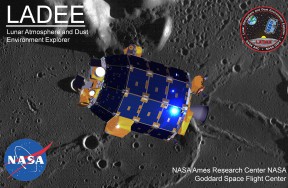 [NTS] – National Technical Systems, Inc., a leading provider of testing and engineering services, announced it completed a series of qualification tests on NASA’s Lunar Atmosphere and Dust Environment Explorer (LADEE), a satellite that will orbit the moon to gather detailed information about the lunar atmosphere, conditions near the moon’s surface and environmental influences on lunar dust. NASA’s LADEE Observatory is scheduled to launch in the late summer of 2013.
[NTS] – National Technical Systems, Inc., a leading provider of testing and engineering services, announced it completed a series of qualification tests on NASA’s Lunar Atmosphere and Dust Environment Explorer (LADEE), a satellite that will orbit the moon to gather detailed information about the lunar atmosphere, conditions near the moon’s surface and environmental influences on lunar dust. NASA’s LADEE Observatory is scheduled to launch in the late summer of 2013.
Working alongside each other, NASA and NTS engineers simulated the conditions of launch and space travel by subjecting LADEE to high levels of acoustics, severe vibration levels and intense shock environments to ensure that the spacecraft will function properly during its trip to the moon. To ensure the spacecraft was uncontaminated, all testing was performed in clean room conditions at NASA’s Ames Research Center at Moffett Field, Calif., and NTS’ Santa Clarita facility. Ames is responsible for managing the mission, building the spacecraft and performing mission operations.
The LADEE project marks the first time for NASA Ames to outsource this type of critical testing to an independent testing laboratory. Typically, these tests are performed in-house or by the prime contractor building the satellite.
A NASA spokesperson said because of the expense of building satellites, such as the LADEE Observatory, it is critical that qualification testing be thorough and reliable.
“The LADEE project is a very important mission for NASA and it is important that we have the highest chance of mission success. This requires undergoing an extensive battery of environmental tests before launch.” said Zion Young, LADEE Mechanical Test Lead. “We try to anticipate all of the mechanical environments that the spacecraft will experience during launch and flight; we then test the spacecraft by simulating these extreme environments using specialized equipment. Once the environmental tests are complete the spacecraft is both physically inspected and functionally tested, certifying the spacecraft is ready for launch, and ready to carry out the mission.”
NTS President and CEO William McGinnis said the NASA testing demonstrates the Company’s ability to simulate difficult environments and perform a rigorous battery of tests in a cost-effective manner.
“We are very pleased that NASA had the confidence in NTS to select us to perform these important tests for its critical LADEE mission to the moon,” McGinnis said. “We have worked diligently to expand and upgrade our capabilities to serve the aerospace and aviation markets, which we consider to be two of the most important markets for NTS for our current and future success. We look forward to continuing to compete for work for NASA and other aerospace customers.”
About LADEE
[NASA] – NASA’s Lunar Atmosphere and Dust Environment Explorer is a robotic mission that will orbit the moon to gather detailed information about the lunar atmosphere, conditions near the surface and environmental influences on lunar dust. A thorough understanding of these characteristics will address long-standing unknowns, and help scientists understand other planetary bodies as well.
The LADEE spacecraft’s modular common spacecraft bus, or body, is an innovative way of transitioning away from custom designs and toward multi-use designs and assembly-line production, which could drastically reduce the cost of spacecraft development, just as the Ford Model T did for automobiles.
Onboard, LADEE will include three science instruments and a technology demonstration.
* Ultraviolet and Visible Light Spectrometer: will determine the composition of the lunar atmosphere by analyzing light signatures of materials it finds.
* Neutral Mass Spectrometer: will measure variations in the lunar atmosphere over multiple lunar orbits with the moon in different space environments.
* Lunar Dust Experiment: will collect and analyze samples of any lunar dust particles in the tenuous atmosphere. These measurements will help scientists address a mystery: was lunar dust, electrically charged by solar ultraviolet light, responsible for pre-sunrise horizon glow that Apollo astronauts saw?
* Lunar Laser Communications Demonstration: will demonstrate the use of lasers instead of radio waves to achieve broadband speeds to communicate with Earth.
NASA's Next Lunar Orbiter Passes Tests in Santa Clarita